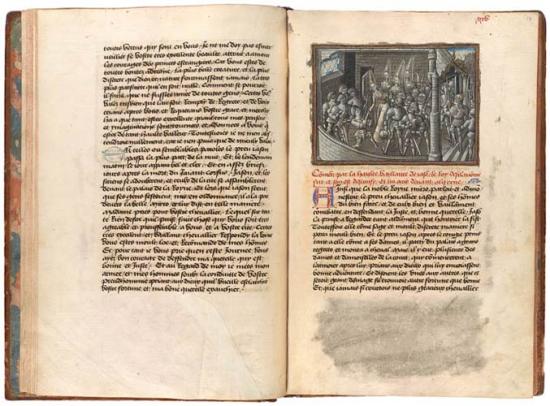
History of Jason, in French
Illuminated in the style of the Master of the Champion des Dames
Purchased by Pierpont Morgan, 1902
Women's Headgear Reaches Its Climax
The look for women in the 1460s and '70s was defined by the turret. In French this headgear was called a haut bonnet (high bonnet) or mitre (after the bishop's ceremonial miter). An attenuated cone, the turret was normally worn with wafting transparent veils. As seen in the miniature here, it was sometimes the custom for these veils to fall below the eyes. The turret was affixed to the head via the templet, a cloth or metal base. At the bottom of each turret shown here is a small hoop: this is the visible part of the templet to which the turret is anchored.
Late Gothic Vertigo
In the 1460s and '70s fashions reached their Gothic climax. The look for both men and women was tall, long, and lean. Thin was in.
The look for men was dominated by the gown, worn either very short (to the crotch—or barely so) or very long (to the ground). Both versions, accented by a thin belt around a narrow waist, featured high padded shoulders and pleats that flared down over the buttocks and up over the back and chest. These features, developed during the previous decades, brought to a culmination the flatteringly masculine V-shaped silhouette. Pouleines, which accented the lean look, were revived. The chaperon, in fashion for over a hundred years, finally went out of style as new hats–especially a tall, loaf-shaped version—arrived.
Women's gowns continued with their wide V necks, high wasp waist, and long trains. For headgear, temples went out of fashion and were replaced by the turret. This cone-shaped coif, from the tip of which cascaded transparent veils, is perhaps the stereotypical ladies' hat from the late Middle Ages.
